 W
WPomatoschistus is a genus of gobies native to fresh, brackish and marine waters of Europe, the eastern Atlantic Ocean and the Mediterranean Sea.
 W
WAcipenser naccarii, the Adriatic sturgeon, is a species of fish in the family Acipenseridae. It is native to the Adriatic Sea and large rivers which flow in it of Albania, Greece, Italy, and States of former-Yugoslavia. Specimens can be seen in several public aquarium, such the Milan Aquarium, Aquarium Finisterrae, Aquarium of the Po, and Oasis of Sant'Alessio in Lombardy.
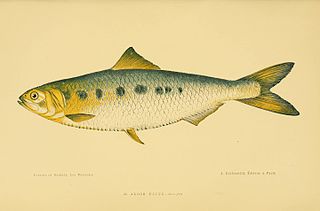 W
WAlosa agone is a species of ray-finned fish in the genus Alosa. It is an endangered species.
 W
WThe Atlantic bonito is a large mackerel-like fish of the family Scombridae. It is common in shallow waters of the Atlantic Ocean, the Mediterranean Sea, and the Black Sea, where it is an important commercial and game fish.
 W
WThe black-faced blenny is a small benthic fish from the family Tripterygiidae (triplefin-blennies). It occurs at depths of 3 to 40 metres and lives on the substrate under large rocks, cliffs or other overhangs.
 W
WC. oestroides is a crustacean isopod, obligate ectoparasite of marine fish that dwells in the buccal cavity. It is the causative agent of various pathologies including tissue damage at the parasitisation site (tongue), growth defects, decrease in mean host weight and size and increases mortalities in farmed and wild fish populations. It has been recorded in six different fish families: Sparidae, Carangidae, Clupeidae, Maenidae, Scorpenidae, and Mugilidae.
 W
WThe Atlantic cod is a benthopelagic fish of the family Gadidae, widely consumed by humans. It is also commercially known as cod or codling. Dry cod may be prepared as unsalted stockfish, as cured salt cod or clipfish.
 W
WThe cusk or tusk is a North Atlantic cod-like fish in the ling family Lotidae. It is the only species in the genus Brosme. Other common names include Tusk, Torsk, European Cusk, Brosmius.
 W
WDiplecogaster bimaculata, the two-spotted clingfish, is a species of fish in the family Gobiesocidae found in Black Sea, Mediterranean Sea and Atlantic Ocean where it is found on rocks and among seagrass or shell beds.
 W
WThe spiny dogfish, spurdog, mud shark, or piked dogfish is one of the best known species of the Squalidae (dogfish) family of sharks, which is part of the Squaliformes order. While these common names may apply to several species, Squalus acanthias is distinguished by having two spines and lacks an anal fin. It is found mostly in shallow waters and further offshore in most parts of the world, especially in temperate waters. Spiny dogfish in the northern Pacific Ocean have recently been reevaluated and found to constitute a separate species, now known as "Pacific spiny dogfish", Squalus suckleyi.
 W
WThe European sturgeon, also known as the Atlantic sturgeon or common sturgeon, is a species of sturgeon previously found on most coasts of Europe. It is anadromous and breeds in rivers. It is currently a critically endangered species. Although the name Baltic sturgeon sometimes has been used, it has now been established that sturgeon of the Baltic region are A. oxyrinchus, a species otherwise restricted to the Atlantic coast of North America.
 W
WThe common goby is a species of ray-finned fish native to fresh and brackish waters along the Atlantic and Baltic Sea coasts of Europe and northern Africa, with a range stretching from Norway to Morocco and Mauritania. It is also found in the Canary Islands. This species reaches a maximum length of 9 centimetres (3.5 in) TL.
 W
WFries's goby is a species of goby native to the Eastern Atlantic Ocean along the coasts of Europe and northern Africa as well as the Mediterranean Sea to the Sea of Marmara. This species burrows into muddy or muddy sand substrates at depths of from 10 to 130 metres and is frequently found in association with the Norway lobster Nephrops norvegicus. This species can reach a length of 13 centimetres (5.1 in) TL. The specific name honours the Swedish zoologist Bengt Fredrik Fries (1799-1839).
 W
WPomatoschistus knerii, Kner's goby, is a species of goby native to the western basin of the Mediterranean Sea and the Adriatic Sea. This species occurs in areas with soft substrates near to rocks or beds of seagrass. The specific name most likely honours the Austrian ichthyologist Rudolf Kner (1810-1869), who was a friend of the author Franz Steindachner.
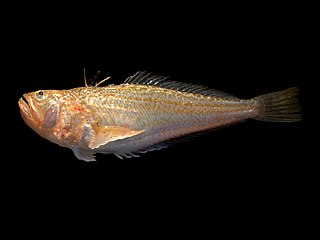 W
WThe lesser weever is a venomous weever of the family Trachinidae, in the order Perciformes, and the class Actinopterygii. It is generally found on the sandy sea beds of the open sea, near the shore. Lesser weevers may sting swimmers badly if disturbed in the water, and fishermen when they clean their fishing nets.
 W
WHippocampus guttulatus, commonly known as the long-snouted seahorse and in Great Britain as the spiny seahorse, is a marine fish belonging to the family Syngnathidae, native from the northeast Atlantic, including the Mediterranean.
 W
WThe Atlantic horse mackerel, also known as the European horse mackerel or common scad, is a species of jack mackerel in the family Carangidae, the jacks, pompanos and trevallies. It is found in the eastern Atlantic Ocean off Europe and Africa and into the south-eastern Indian Ocean. It is an important species in commercial fisheries and is listed as a Vulnerable species on The IUCN Red List of Threatened Species.
 W
WThe marbled electric ray is a species of electric ray in the family Torpedinidae found in the coastal waters of the eastern Atlantic Ocean from the North Sea to South Africa. This benthic fish inhabits rocky reefs, seagrass beds, and sandy and muddy flats in shallow to moderately deep waters. It can survive in environments with very little dissolved oxygen, such as tidal pools. The marbled electric ray has a nearly circular pectoral fin disc and a muscular tail that bears two dorsal fins of nearly equal size and a large caudal fin. It can be identified by the long, finger-like projections on the rims of its spiracles, as well as by its dark brown mottled color pattern, though some individuals are plain-colored. Males and females typically reach 36–38 cm (14–15 in) and 55–61 cm (22–24 in) long respectively.
 W
WThe common pandora is a fish of the sea bream family, Sparidae. It is a popular food fish in Mediterranean countries, with delicate white flesh.
 W
WThe greater pipefish is a pipefish of the family Syngnathidae. It is a seawater fish and the type species of the genus Syngnathus.
 W
WThe lesser pipefish or Nilsson's pipefish is a pipefish similar to the greater pipefish, but with no crest above the head. Usually it reaches up to 17 centimetres (6.7 in) in length, maximally 18 centimetres (7.1 in), although in South Wales they are usually not more than 10 to 13 centimetres long. They have a light to dark green-brown colour with bar-like markings on the sides. Lesser pipefish are found all around the British Isles and as far as the French coast, although they have now been recorded in the Mediterranean Sea.
 W
WThe shagreen ray, also known as shagreen skate or fuller's ray, is a species of skate in the family Rajidae. This ray is found in the eastern Atlantic Ocean, from Murmansk, Russia through Norway, southern Iceland, the Faroe Islands, the Celtic Sea, the northern North Sea and Skagerrak, to northern Morocco, including (infrequently) the western Mediterranean Sea and the Madeira Islands. It is absent from the shallow waters off England and Wales.
 W
WThe Russian sturgeon, also known as the diamond sturgeon or Danube sturgeon, is a species of fish in the family Acipenseridae. It is found in Azerbaijan, Bulgaria, Georgia, Iran, Kazakhstan, Romania, Russia, Turkey, Turkmenistan, and Ukraine. It is also found in the Caspian Sea. This fish can grow up to about 235 cm (93 in) and weigh 115 kg (254 lb). Russian sturgeon mature and reproduce slowly, making them highly vulnerable to fishing. It is distinguished from other Acipenser species by its short snout with a rounded tip as well as its lower lip which is interrupted at its center.
 W
WThe sand goby, also known as a polewig or pollybait, is a species of ray-finned fish native to marine and brackish waters European waters from the Baltic Sea through the Mediterranean Sea and into the Black Sea where it occurs in sandy or muddy areas of inshore waters at depths of from 4 to 200 metres. This species can reach a length of 11 centimetres (4.3 in) TL. This species is sometimes kept in public aquariums. The sand goby is of a sandy colour, with darker markings on the sides and a creamy-white underside. In the breeding season the male fish has blue spot at the rear of the first dorsal fin, ringed with white. The fish has a slender body, and the head is about a quarter of the total length.
 W
WThe sargo or white seabream is a species of seabream native to the eastern Atlantic and western Indian Oceans. It is found from the Bay of Biscay southwards to South Africa, including Madeira and the Canary Islands, the Mediterranean and (rarely) the Black Sea. Occasionally individuals are found off the Indian Ocean coasts of South Africa, Mozambique and Madagascar, and they are very rarely found elsewhere in the Indian Ocean, such as off Oman. An active fish, they inhabit the surf zone, but they may be found down to 50 m.
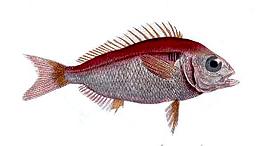 W
WThe blackspot seabream, also known as the red seabream, is a marine ray-finned fish species in family Sparidae. It is widespread in the Eastern Atlantic from Norway to Mauritania, including Macaronesia and the western Mediterranean.
 W
WThe common seasnail is a small marine fish of the seasnail family (Liparidae) in the order Scorpaeniformes, the scorpionfishes and flatheads. It is found in the northeastern Atlantic Ocean where it lives on the seabed.
 W
WThe allis shad is a widespread Northeast Atlantic species of fish in the herring family, Clupeidae. It is an anadromous fish which migrates into fresh water to spawn. It is found in the eastern Atlantic Ocean, the western Baltic Sea and the western Mediterranean Sea. In appearance it resembles an Atlantic herring but has a distinctive dark spot behind the gill cover and sometimes a row of up to six spots behind this. It sometimes hybridises with the twait shad. This fish becomes mature when three or more years old and migrates to estuaries, later swimming up rivers to spawn. Populations of this fish have declined due to overfishing, pollution and habitat destruction. Conservation of this species is covered by Appendix III of the Bern Convention and Appendix II and V of the European Community Habitats Directive.
 W
WThe twait shad or twaite shad is a species of fish in the family Clupeidae. It is found in the eastern Atlantic Ocean and the Mediterranean Sea and is an anadromous fish which lives in the sea but migrates into fresh water to spawn. In appearance it resembles an Atlantic herring but has a row of six to ten distinctive spots on its silvery flanks. They become mature when three or more years old and migrate to estuaries, later swimming up rivers to spawn. Populations of this fish have declined due to overfishing, pollution and habitat destruction. Conservation of this species is covered by Appendix III of the Bern Convention and Appendix II and V of the European Community Habitats Directive.
 W
WThe school shark is a houndshark of the family Triakidae, and the only member of the genus Galeorhinus. Common names also include tope shark, snapper shark, and soupfin shark. It is found worldwide in temperate seas at depths down to about 800 m (2,600 ft). It can grow to nearly 2 m long. It feeds both in midwater and near the seabed, and its reproduction is ovoviviparous. This shark is caught in fisheries for its flesh, its fins, and its liver, which has a very high vitamin A content. The IUCN has classified this species as critically endangered in its Red List of Threatened Species.
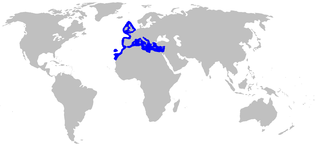 W
WThe common smooth-hound is a houndshark of the family Triakidae. It is found in the eastern Atlantic Ocean from the British Isles to South Africa, and in the Mediterranean Sea, Madeira, and the Canary Islands at depths ranging from 5 m to 625 m. While they can grow to 200 cm, their usual maximum size is 150 cm. They commonly grow to 100–120 cm with a birth length around 35 cm. The reproduction of commons smooth-hounds is viviparous.
 W
WThe starry smooth-hound is a houndshark of the family Triakidae. It is found on the continental shelves of the northeast Atlantic, between latitudes 61° N and 16° N, from the surface to a depth of 200 m (660 ft). It can grow up to a length of 1.4 m.
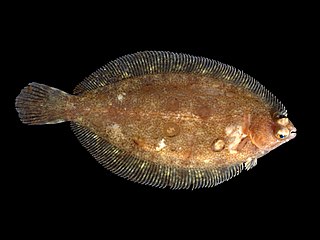 W
WThe lemon sole is a flatfish of the family Pleuronectidae. It is native to shallow seas around Northern Europe, where it lives on stony bottoms down to depths of about 200 metres (660 ft). It grows up to 65 centimetres (26 in) in length and reaches about 3 kilograms (6.6 lb) in weight.
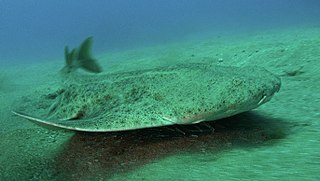 W
WSquatina squatina, the angelshark or monkfish, is a species of shark in the family Squatinidae, that were once widespread in the coastal waters of the northeastern Atlantic Ocean. Well-adapted for camouflaging itself on the sea floor, the angelshark has a flattened form with enlarged pectoral and pelvic fins, giving it a superficial resemblance to a ray. This species can be identified by its broad and stout body, conical barbels, thornless back, and grayish or brownish dorsal coloration with a pattern of numerous small light and dark markings. It measures up to 2.4 m (7.9 ft) long.
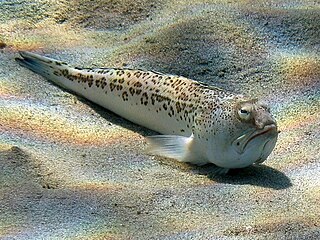 W
WThe starry weever, or streaked weever, Trachinus radiatus, is a fish of the family Trachinidae widespread in the eastern Atlantic from Gibraltar to the Gulf of Guinea, and probably further south; it is also known from the Mediterranean Sea. A marine subtropical fish, it grows up to 50 cm (20 in) in length.
 W
WThe sea stickleback, also known as the fifteen-spined or fifteenspine stickleback, is a species of stickleback which lives in benthopelagic and in brackish environments of the northeastern Atlantic Ocean. This species, the largest of the sticklebacks, grows to a length of 22 centimetres (8.7 in) SL. This species is the only known member of its genus Spinachia. It is of no interest as a commercial fish.
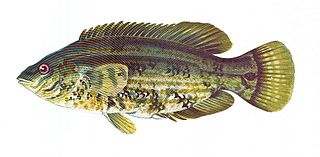 W
WBaillon's wrasse is a species of wrasse native to the eastern Atlantic Ocean from the British Isles and Belgium to Mauritania and the western Mediterranean Sea along the coast of Spain and around the Balearic Islands. This species inhabits areas with plentiful weed growth or around rocks at depths from 1 to 50 m. It can reach 23 cm (9.1 in) in standard length, though usually not exceeding 18 cm (7.1 in). The British Record for the heaviest fish is 285 grams caught in Poole Bay, Dorset on 3 September 2018 by David Lynes It is caught for human consumption in artisanal fisheries.
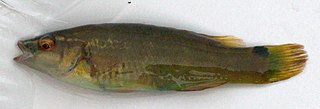 W
WThe goldsinny wrasse is a species of ray-finned fish, a wrasse from the family Labridae which is native to the eastern Atlantic Ocean and associated seas. This species is the only known member of its genus.
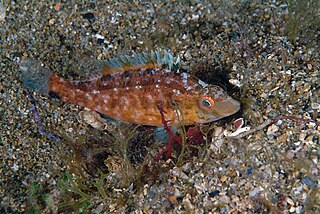 W
WThe grey wrasse is a species of wrasse native to the eastern Atlantic Ocean and along the coasts of the Mediterranean Sea to the Black Sea. It inhabits coastal waters, preferring beds of eelgrass at depths from 1 to 20 m. It can reach 16 cm (6.3 in) in total length, though most do not exceed 8 cm (3.1 in). It is important to local peoples as a food fish and is popular as a game fish. It can also be found in the aquarium trade.